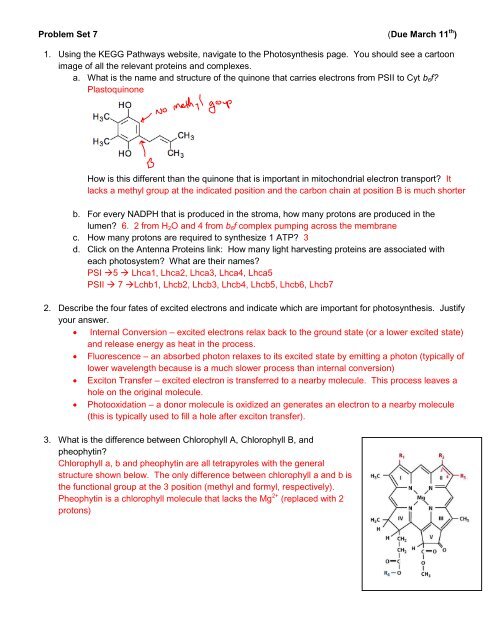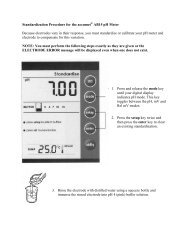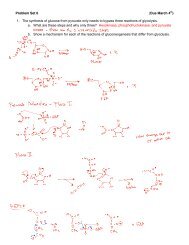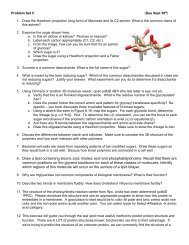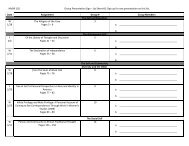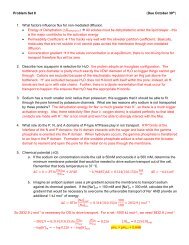Problem Set 7 Key
Problem Set 7 Key
Problem Set 7 Key
- No tags were found...
You also want an ePaper? Increase the reach of your titles
YUMPU automatically turns print PDFs into web optimized ePapers that Google loves.
<strong>Problem</strong> <strong>Set</strong> 7 (Due March 11 th )1. Using the KEGG Pathways website, navigate to the Photosynthesis page. You should see a cartoonimage of all the relevant proteins and complexes.a. What is the name and structure of the quinone that carries electrons from PSII to Cyt b 6 f?PlastoquinoneHow is this different than the quinone that is important in mitochondrial electron transport? Itlacks a methyl group at the indicated position and the carbon chain at position B is much shorterb. For every NADPH that is produced in the stroma, how many protons are produced in thelumen? 6. 2 from H 2 O and 4 from b 6 f complex pumping across the membranec. How many protons are required to synthesize 1 ATP? 3d. Click on the Antenna Proteins link: How many light harvesting proteins are associated witheach photosystem? What are their names?PSI 5 Lhca1, Lhca2, Lhca3, Lhca4, Lhca5PSII 7 Lchb1, Lhcb2, Lhcb3, Lhcb4, Lhcb5, Lhcb6, Lhcb72. Describe the four fates of excited electrons and indicate which are important for photosynthesis. Justifyyour answer. Internal Conversion – excited electrons relax back to the ground state (or a lower excited state)and release energy as heat in the process. Fluorescence – an absorbed photon relaxes to its excited state by emitting a photon (typically oflower wavelength because is a much slower process than internal conversion) Exciton Transfer – excited electron is transferred to a nearby molecule. This process leaves ahole on the original molecule. Photooxidation – a donor molecule is oxidized an generates an electron to a nearby molecule(this is typically used to fill a hole after exciton transfer).3. What is the difference between Chlorophyll A, Chlorophyll B, andpheophytin?Chlorophyll a, b and pheophytin are all tetrapyroles with the generalstructure shown below. The only difference between chlorophyll a and b isthe functional group at the 3 position (methyl and formyl, respectively).Pheophytin is a chlorophyll molecule that lacks the Mg 2+ (replaced with 2protons)
4. As we discussed in class, there are roughly 300 chlorophyll molecules for every photosynthetic reactioncenter. Noting that not all of these chromophores are part of the reaction center, what is the role ofthese additional molecules? Please discuss the proteins that harbor these additional chloryphyllmolecules and how your answer to problem 1 is relevant.There are numerous light harvesting complexes that surround photosynthetic reaction centers. Thisincreases the number of photons that can be absorbed. These complexes are largely decorated withchlorophyll molecules and a number of other chromaphores (e.g. lutein and carotene). The absorbedphotons at these light harvesting complexes are transferred to a photosynthetic reaction center by aseries of exciton transfer processes.5. The Z scheme and the red drop are two important features of photosynthesis. Describe what is meantby each of these terms. In addition, please describe an experiment that uses the red drop to confirmthe Z scheme. (include a sketch of the data and explain what it means).The Z-scheme is a term that describes the coupled nature of PSII and PSI. An excited electron fromPSII gets transferred to PSI and is subsequently excited at that reaction center. The red drop is a termthat describes the sharp drop off in photosynthesis efficiency when red light is the primary energysource. This is due to the fact that red light does not excite PSII very well.The experiment that confirms the Z scheme was described in class. It relies on the signal that isgenerated when cyt f is oxidized. Using red light as the sole light source results in an increased signalas cyt f transfers its electrons to PSI. This results in an oxidation and increased signal. However, whenthe red light is supplemented with yellow-green light, the signal decreases, indicating that cyt f is beingreduced. The only possible explanation is that PSII is providing electrons to cyt f.
6. Energy and efficiency:a. How many photons of red light ( = 650 nm) are needed to produce 1 O 2 from 2 H 2 O?Noting that water oxidation is coupled to NADP+ reduction:A single photon of 650 nm light:Converting to molar energy:The number of photons is the ratio:b. Noting that it takes 8 photons to carry out this process, how efficient is photosynthesis?c. So clearly energy is lost in this process. Propose a reason for the energy loss.Exciton transfer and internal conversion are both huge pieces of photosynthesis. Both of theseprocesses provide avenues for energy loss – internal conversion results in loss of energy in theform of heat and exciton transfer can release a photon from the antenna complex prior to transfer toa reaction centerd. For every O 2 that is produced at the OEC, 12 protons are accumulated in the thylakoid lumen.Account for all of these protons (problem 1 should help with this) 2 H 2 O are required for 1 O 2 ,so 4 H + . For every O 2 , 4 H + are pumped by the b 6 f complex, so another 8.8+4=12e. Calculate how many ATP are produced per photon of red light ( = 650 nm) – remember toaccount for the efficiency that you determined in 5b.f. Noting that it takes 30.5 kJ mol -1 to make ATP from ADP and Pi, how many photons ( = 650nm) should be theoretically needed?
7. Photosynthetic Reaction Center:a. Using the crystal structure of the photosynthetic reaction center from Rps. viridis, (pdbID 1PRC),make an image that shows just the redox cofactors (you should be able to make it resembleFigure 29-57 in your book). Color the Special Pair red, menaquinone black, ubiquinone blueand the pheophytins green.b. What is the distance between Mg 2+ ions in the special pair? What is the reason that these twochlorophyll molecules are so close? 7.58 angstroms. These two chlorophylls are so close sothat the redox potential is modulated in a way that electrons from the light harvesting complexeswill be transferred to this special pair in a thermodynamically favorably way (º special pair >harvesting complex).c. Please show the sequence of electron transfer steps in this reaction center and list theapproximate times it takes for each step.Special pair pheophytin (~3 ps)Pheophytin menaquinone (Q A ) (200 ps)menaquinone (Q A ) ubiquinone (Q B ) (100 s)d. Recalling that fluorescence and internal conversion are very slow processes (~ 200s), what isthe significance of the rate of electron transfer in the scheme you determined in 7c? In half thetime it takes for the electron to fluoresce and relax back to the ground state, the excited electronis transferred through all cofactors and stabilized on ubiquinone for shuttle to cytochrome bc 1(b 6 f in plants). If the electron were allowed to be released via fluorescence, the electrontransport chain would terminate and photosynthesis would fail.e. What is the source of electrons that fill the hole that is formed upon photon absorption in PSIand PSII? In PSI, the electron hole is filled by a reduced plastocyanin (PC), which is a result ofelectron transfer FROM PSII through Cyt. b 6 f. The electron hole on PSII is filled by oxidation ofwater to O 2 .f. What is the fate of electron that is excited at PSII? NADP+ NADPH
8. Draw a reaction mechanism for the carbon fixation step of the Calvin Cycle.9. Predict the product of a transketolase reaction betweenthe two molecules to the right.
10. As noted in class, the Calvin Cycle image shown in the lecture slides contains an error in the 2 ndtransketolase reaction (S7P + GAP).a. Show the mechanism of this reaction and determine what the products should be.b. The aldose that is produced in this reaction can be converted directly to Ru5P in a mechanismthat is identical to one of the steps in glycolysis. Identify the enzyme that catalyzes thistransformation and predict a mechanism.11. Triose phosphates are the direct product of the Calvin Cyclea. Which triose phosphates are produced? GAP or DHAPb. How can these compounds be converted to hexose phosphates and pentose phosphates?GAP+DHAP FBP (aldolase)FBPF6P (FBPase-1)F6P G6P (PGI)G6P pentoses (you can use your book or KEGG to see that this happens)
12. Read the manuscript attached to answer the following questions:a. Ferredoxin is important in a wide variety of cellular processes including carbon assimilation,nitrogen assimilation, sulfur assimilation and cellular redox control. It participates in theseprocesses through interactions with a variety of proteins. For each of the pathways listedabove, identify one or more partner proteins. Which of these interactions is important inphotosynthesis?Carbon assimilation Ferredoxin-NADP+ reductase (FNR) this one is important inphotosynthesisNitrogen assimilation nitrite reductase and glutamate synthaseSulfur assimilation Sulfite reductase (SiR)Redox regulation ferredoxin-thioredoxin reductaseb. Describe the goals of this study. It has been postulated that Fd interacts with partner proteinsbased on surface charge. The authors want to determine what residues dictate specificity forFNR vs. SiRc. What amino acids were mutated in this study and why? The authors selected acidic residuesthat are predicted to decorate the exterior of the protein. D27, E30, D58, D61, D66, D67, E71,E72, D85, E93. All were mutated to the corresponding neutral residue (EQ and DN) orbasic amino acids in one case.d. How did the investigators confirm that site-directed mutants don’t significantly perturb proteinstructure? They used CD spectroscopy and determined the redox potential, which woulddeviate significantly if the structure was perturbed.e. Figure 5 confirms that Fd and SiR form a complex at pH 7.5. Describe how this conclusion wasreached based on the data. The proteins were added together in a gel filtration chromatographyexperiment. If the proteins don’t interact, two independent peaks should show up correspondingto Fd and SiR. However, the authors saw a peak that corresponded to a complex bigger thaneither of the individual proteins; the only reasonable explanation is that a complex is formed.f. Compare the results from Figure 6 to the activity data from Table 2. Describe any correlationobserved between these two pieces of experimental data. It’s expected that the mutants withdecreased affinity for each other should have dampened activity (since the activity is a measureof electron transfer between the two proteins, which requires an interaction). Indeed, themutants that have a dampened affinity also have a decreased activity.


